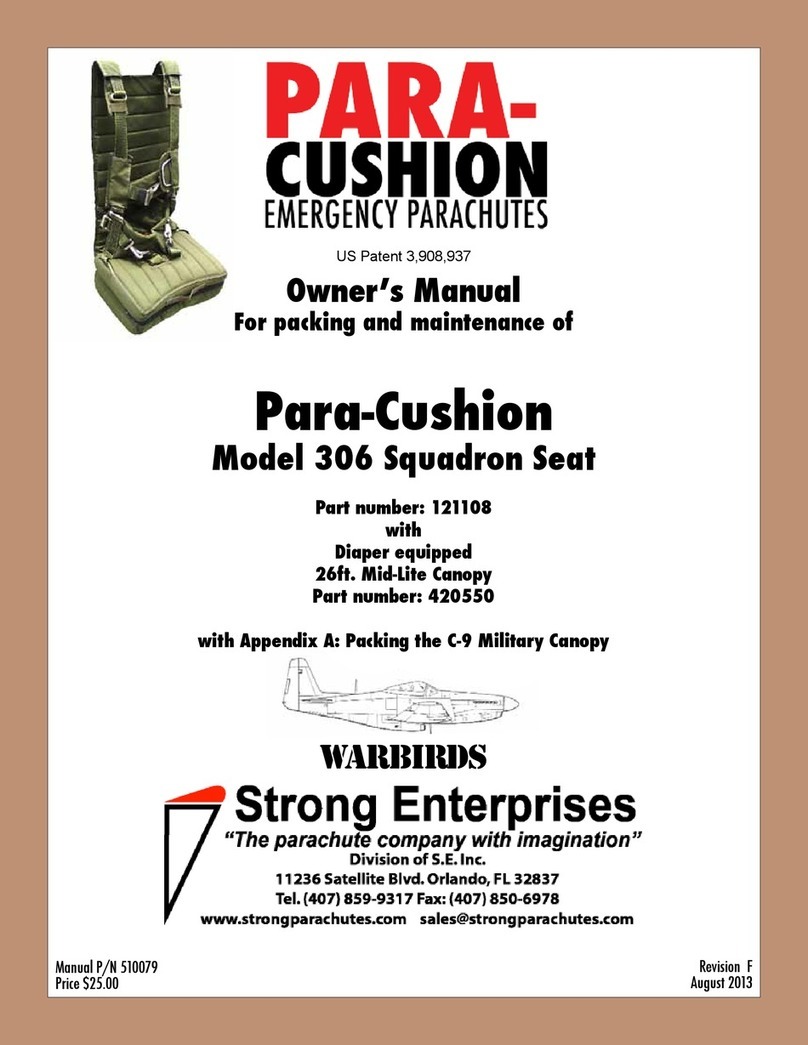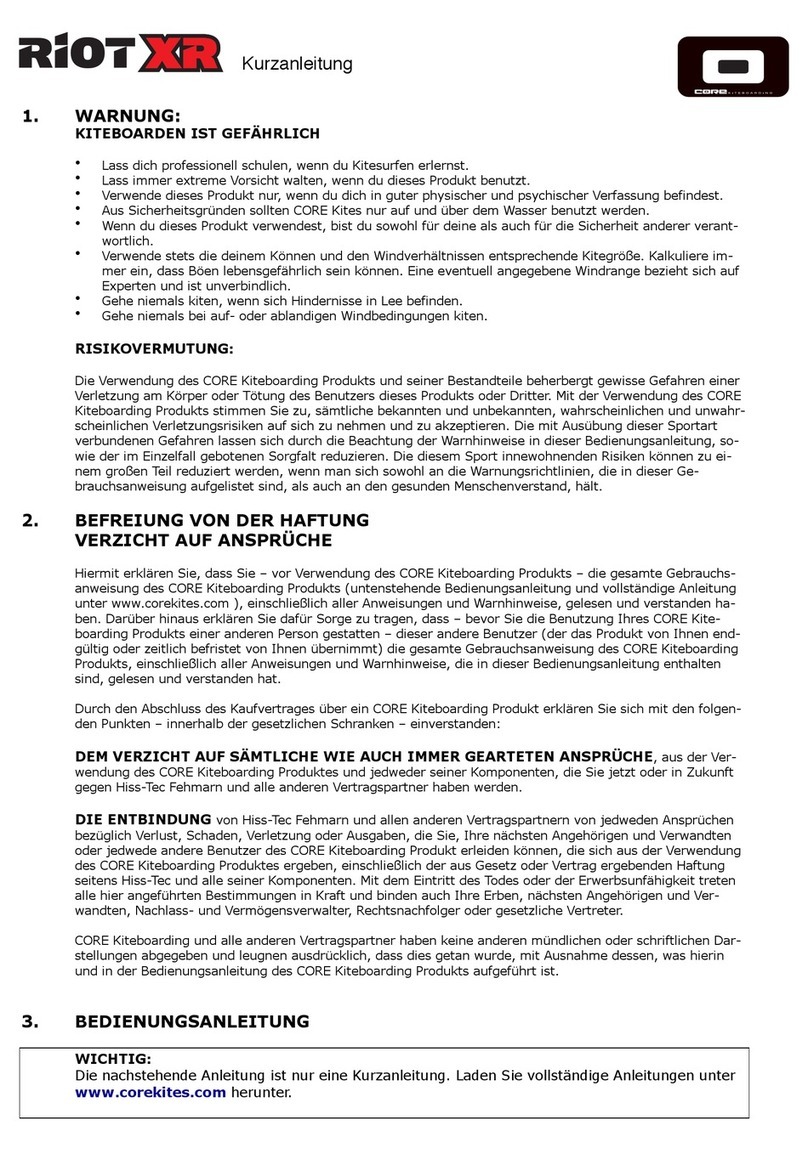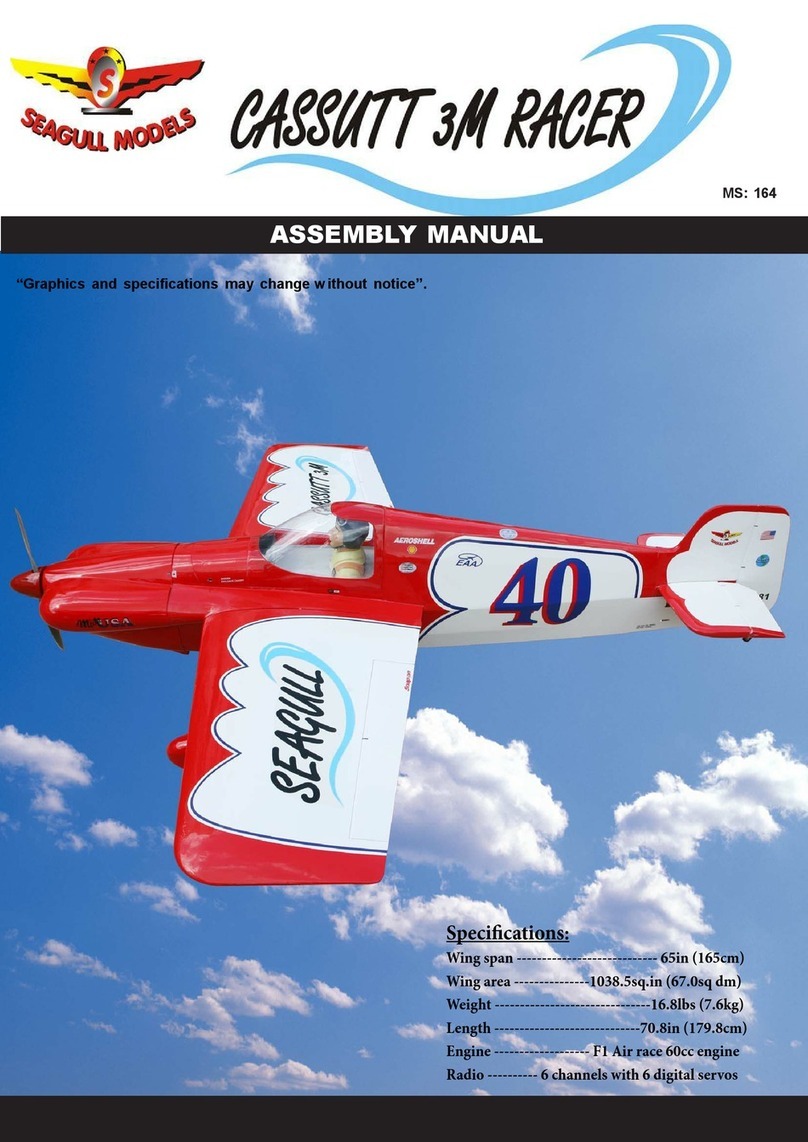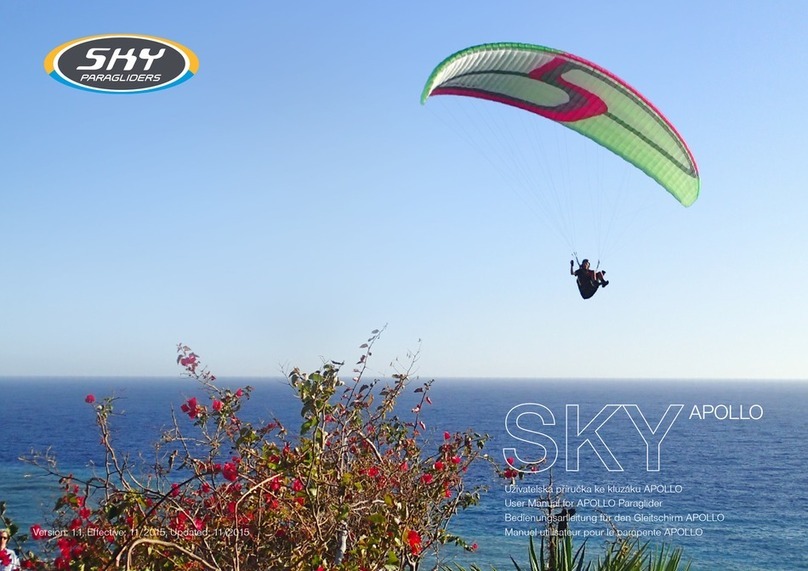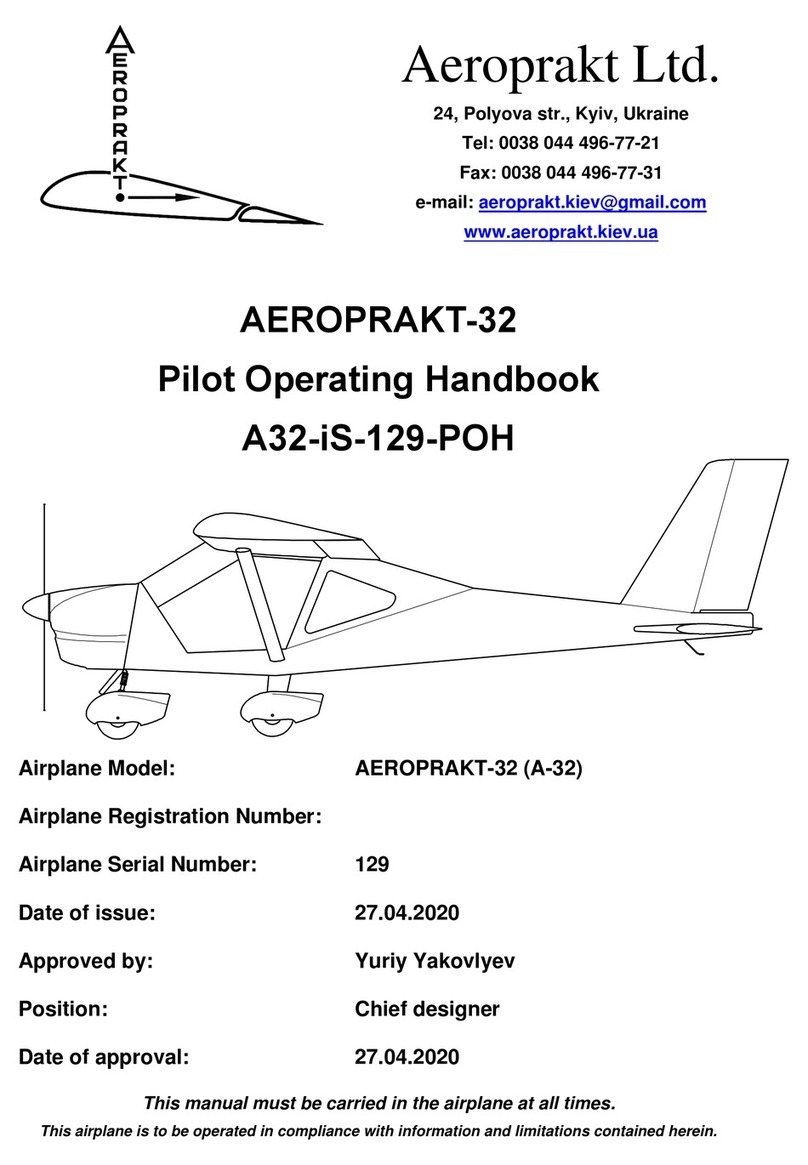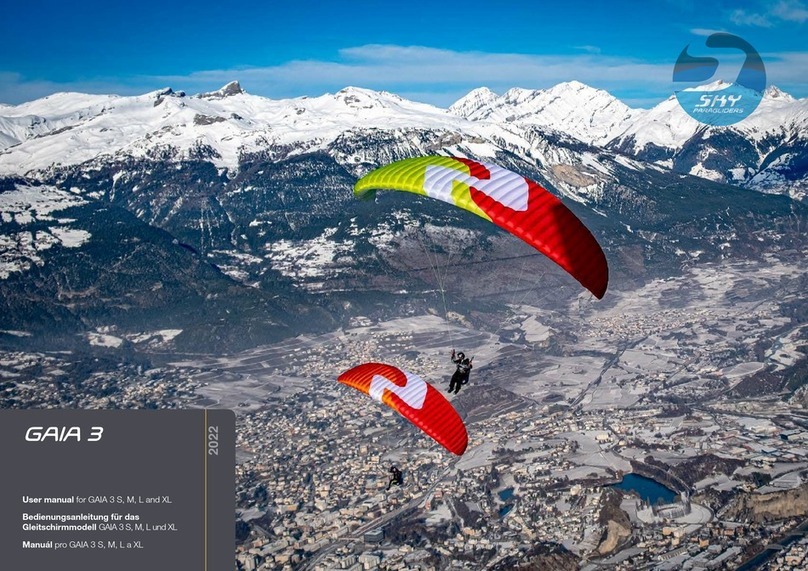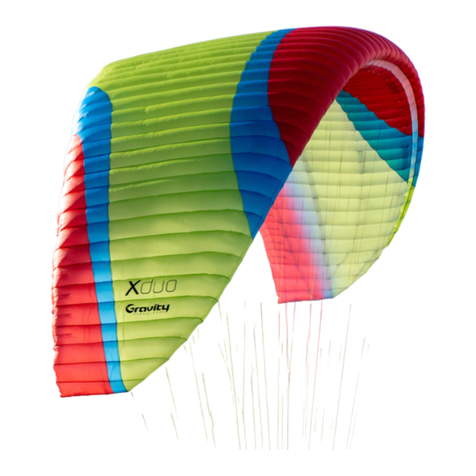Strong Enterprises DHT SET-400 with Canopy User manual

Owner’s Manual
For packing and maintenance of
Dual Hawk
Tandem System
with
SET-400 & SET-366 Main Canopies
Part number: 411540 & 411366
and
Master Reserve Canopy
Part number: 430085
Revision L: January 2016Manual P/N 510045
Price $25.00

! WARNING !
Parachuting is a hazardous activity that can result in serious injury or death.
Failure to follow all warnings, instructions and required procedures may
result in serious injury or death. Parachutes sometimes malfunction even
when they are properly designed, built, assembled, packed, maintained
and used. The results of such malfunctions are sometimes serious injury
or death. There are so many factors, both human and natural beyond our
control, that we want you to clearly understand that by using or intending
to use our equipment, you are assuming a considerable risk of personal
injury or death. If you are not willing to assume that risk, please return the
equipment to the dealer where it was purchased for a full refund.
DISCLAIMER
There are NOWARRANTIES that extend beyond the description of the products
in this manual and neither the seller nor any agent of the seller has made
any afrmation of the fact or promise with respect to the products except
those that appear therein.
The liability of the seller is limited to the duty to replace defective parts
found upon examination by the manufacturer to be defective in material
or workmanship within 7 days after purchase and found not to have been
caused by any accident, improper use, alteration, tampering, abuse or lack
of care on the part of the purchaser.
This is a high performance parachute system and must be packed in
accordance with the instructions in this manual.
Any person using this equipment must have successfully completed
a Strong Enterprises Certication Course (TICC). The correct use of this
equipment shall be the responsibility of the Strong Enterprises Certied
Tandem Instructor.

3
11236 Satellite Blvd. Orlando, FL 32837 Tel.: (407) 859-9317 Fax: (407) 850-6978 www.strongparachutes.com
Strong Enterprises Owner’s Manual. Dual Hawk Tandem System - Revision L: 1/16
Congratulations on the Purchase of your
NEW
Dual Hawk
Tandem System
This Manual is organized into ve separate sections.
Section One contains the general information concerning your new DHT system.
Section Two contains Instructor information.
Section Three contains the inspection and maintenance requirements.
Section Four contains the rigging procedures.
Section Five contains the Appendices.
Each section contains valuable information concerning this DHT system and it is
required that you read all sections completely prior to use. In addition all persons
must successfully complete a Strong Enterprises Tandem Instructor Certication
Course (TICC) before using this equipment.
All Tandem jumps made on the DHT System must be completed in accordance
with the rules of the country in which the jump is preformed (in the US: FAA FAR
105.45), this operation manual, and the Strong Enterprises Training Syllabus for
the Tandem Instructor Certication Course (TICC). Any violation of these procedures
will cause revocation of privileges.

4
11236 Satellite Blvd. Orlando, FL 32837 Tel.: (407) 859-9317 Fax: (407) 850-6978 www.strongparachutes.com
Strong Enterprises Owner’s Manual. Dual Hawk Tandem System - Revision L: 1/16
Table of Contents
Warning/Disclaimer
Table of Contents .......................................................................4
Section 1 ................................................................................1-1
1.0 Introduction to Tandem Skydiving ..................................................................................................1-2
1.1 Scope ..................................................................................................................................................1-2
1.2 Operational Limitations ...................................................................................................................1-2
1.3 Parachute Repack Interval ...............................................................................................................1-3
1.4 System Description ...........................................................................................................................1-3
1.5 Reporting of Equipment Improvement Recommendations .............................................................1-8
Section 2 ................................................................................2-1
2.0 Introduction .......................................................................................................................................2-1
2.1 System Function ...............................................................................................................................2-2
2.2 Harness Fitting .................................................................................................................................2-4
2.3 Operator Pre-Jump Inspection .........................................................................................................2-8
Section 3 ................................................................................3-1
3.0 Introduction .......................................................................................................................................3-2
3.1 Care of your Dual Hawk System ......................................................................................................3-2
3.2 System Service Life ...........................................................................................................................3-2
3.3 Inspections and Maintenance ...........................................................................................................3-2
3.4 Repair Guidelines ..............................................................................................................................3-7
3.5 Closing loop Construction .................................................................................................................3-9
Section 4 ................................................................................4-1
4.0 Introduction .......................................................................................................................................4-2
4.1 Approved Components ......................................................................................................................4-2
4.2 Packing Tools and Consumables ......................................................................................................4-3
4.3 Preparing the Reserve Container and Canopy ................................................................................4-4
4.4 Packing of the Master Reserve Canopy ...........................................................................................4-7
4.5 Closing the Reserve Container .......................................................................................................4-24
4.6 Preparing the Main Canopy ...........................................................................................................4-33
4.7 Packing the Main Canopy ...............................................................................................................4-36
4.8 Closing the Main Container ...........................................................................................................4-45
4.9 Packing the Drogue .........................................................................................................................4-50
Section 5 ................................................................................5-1
Appendix A: Line Charts ........................................................................................................................5-2
Appendix B: TSO Letter for Dual Hawk Tandem System ..................................................................5-11
Appendix C: Dual Hawk Tandem Inspection Checklist .....................................................................5-12

1-1
11236 Satellite Blvd. Orlando, FL 32837 Tel.: (407) 859-9317 Fax: (407) 850-6978 www.strongparachutes.com
Strong Enterprises Owner’s Manual. Dual Hawk Tandem System - Revision L: 1/16
Section One:
General Information

1-2
11236 Satellite Blvd. Orlando, FL 32837 Tel.: (407) 859-9317 Fax: (407) 850-6978 www.strongparachutes.com
Strong Enterprises Owner’s Manual. Dual Hawk Tandem System - Revision L: 1/16
1.0 Introduction To Tandem Skydiving
The chronicle of tandem skydiving, like so many elements of our sport, began with the vision
and enthusiasm of an experienced skydiver trying something new. More signicantly, to share
the thrill of freefall skydiving with someone else. It was 1977 and most parachutes in use were
“rounds”. Parachute technology was evolving but still far behind today’s sophisticated equipment
and procedures.
The skydiver took his wife as his rst “Tandem Student,” strapping her into the same harness with
him for the experiment. Encouraged by the relative success, other skydivers made more jumps.
In November 1982 intrigued by the possibilities of an
actual training program centered on tandem skydiving,
Ted Strong and Bill Morrissey began engineering the
tandem concept into real equipment made specically for
tandem jumping.
The rst tandem jump made on this newly engineered
equipment was made in January 1983 with Ted Strong
as the tandem pilot and Ricky Meadows, an employee at
Strong Enterprises, the student.
During the next two and a half years hundreds of experimental tandem jumps were made. During
this time the student ripcord, Master Reserve, and drogue systems were all incorporated into the
design and resulted in tandem skydiving equipment and procedures reaching an acceptable level
of feasibility and more importantly, safety. In 1987, US Patent #4,746,084 was issued to Strong
Enterprises for this original and pioneering work on the major tandem concepts.
Commitment to development and innovation continues today. We at Strong Enterprises are
constantly creating new and innovative products living up to the name “The parachute company
with imagination”!
Today, almost one million tandem skydives are made each year, bringing the thrill of freefall
skydiving to a vast and more diverse audience than ever before while giving the student a measure
of safety not available during other teaching methods.
1.1 Scope
This DHT manual P/N 510045 is a component of the DHT system, it covers the manufacturer’s
instructions for the assembly, operation, packing, maintenance and approved components of this
Dual Hawk Tandem Parachute System.
1.2 Operational Limitations
The Strong Enterprises Dual Hawk Tandem System is specically designed for two people with
total loads of up to 500 lbs and opening speeds up to 175 knots IAS. The use of unapproved parts
and components is prohibited.

1-3
11236 Satellite Blvd. Orlando, FL 32837 Tel.: (407) 859-9317 Fax: (407) 850-6978 www.strongparachutes.com
Strong Enterprises Owner’s Manual. Dual Hawk Tandem System - Revision L: 1/16
1.3 Parachute Repack Interval
The Strong Enterprises Master Reserve Canopy has a 365-day repack cycle. Your countries laws
may dictate a stricter schedule, check your local regulations. The reserve canopy must be packed
by an FAA certicated parachute rigger with a back type rating, military equivalent, or foreign
equivalent. Alternately it may be returned to Strong Enterprises or an authorized Recertication
Center for complete inspection and repack. If your DHT system is exposed to moisture, excessive
dirt or is damaged it should be inspected sooner than the maximum allowed. All records must be
kept in accordance with regulations.
Note!
USA current repack regulations can be found in FAA FAR 105.43
1.4 System Description
The Strong Enterprises Dual Hawk Tandem Parachute System is designed for freefall and open
canopy dual instruction applications. It allows two people, a Strong Enterprises Certied Tandem
Instructor in the rear and a student in the front, to jump using one extra large main parachute
while having the back up reliability of a compatible reserve parachute. The packed system, ready
to jump, measures 26 inches long by 16 inches wide by 8 inches thick.
The complete assembly consists of the Dual Hawk Tandem instructor harness and container
assembly, a student harness, the main deployment system, and the reserve deployment system.
All Tandem jumps made on the DHT System must be completed in accordance with FAA FAR
105.45 (or local regulations), this operation manual, and the Training Syllabus for the Tandem
Instructor Certication Course (TICC). Any violation of these procedures will cause revocation of
privileges.
1.4.1 Dual Hawk Main Harness/Container Description
1.4.1.1 Instructor Harness
The harness is made using type 7 webbing. The type 7 has a tensile strength of 6,000 lbs. It is
integrated directly into the container. The harness has integrated reserve risers and drogue risers
that ensure loads are evenly spread throughout. The harness is secured to the instructor by three
adjustable attachment points; one chest strap and two leg straps. Additionally there are two lower
adjustment points that allow users of all shapes and sizes a comfortable and secure t.
The specially designed 3-D ring was pulled to 11,200 lbs with only a .002” distortion.
Its unique design attaches the student harness directly to the main and reserve
canopies which has multiple benets. It allows independent loading of the instructor
and student harnesses under the main or reserve canopy. This means that the Tandem
Instructor can y under the canopy unencumbered by the weight of the student. It
also keeps the students weigh and g-forces from transferring to the instructor harness,
instead it is transferred directly to the canopy via the 3-D ring. In addition, since it
is a solid piece of hardware it isn’t consistently stretching the main lift webbing, thus
eliminating a wear point and extending the life of the harness.

1-4
11236 Satellite Blvd. Orlando, FL 32837 Tel.: (407) 859-9317 Fax: (407) 850-6978 www.strongparachutes.com
Strong Enterprises Owner’s Manual. Dual Hawk Tandem System - Revision L: 1/16
1.4.1.2 Container
The container is made of 1,000 denier nylon Cordura and parafoam
materials. The Cordura outside creates a rugged long lasting container
that can take the abuse of years of jumping. The parafoam inside allows
a cushioned smooth surface for the more delicate line and parachute
materials. The container consists of three parts, the reserve pack tray,
the main pack tray, and the backpad.
The reserve pack tray is equipped with all the pockets and channels
to allow the installation of a two pin tandem AAD. The closing ap
conguration allows for clean, quick reserve deployments. With only two
aps to clear, the pilot chute looses little to no momentum leaving the
pack tray and is quickly in clean air extracting the reserve canopy. The
guide rings on the top ap ensure that ripcord pins remain untangled, unbent, and allow a quick
inspection of pins, RSL ring, and routing giving the instructor peace of mind knowing everything is
in order. No complicated rigging to inspect! On the outside bottom of the reserve container there is
a small hide-away pocket that can be used for spare closing loops and through loops.
The main pack tray is designed to hold canopies from 360 sq. ft. to 520 sq. ft. This is achieved
through our innovative ap and two-loop conguration. The closing aps fold neatly around the
main deployment bag and the two loop closing ensures that even if the closing pin is worked loose
from one loop the top and bottom aps will secure the deployment bag until the instructor is ready
to deploy the main canopy. The dura-stretch pouch on the outside bottom of the main pack tray
ensures a secure and accessible position for the drogue. Covered channels along the outside of the
main pack tray secure the drogue bridle preventing accidental and unwanted snags while allowing
quick and easy deployment when the drogue is tossed during free fall.
1.4.1.3 Handles and RSL
The DHT has four handles each with a specic purpose.
There are two drogue release handles. The handles are a PVC grip with
a 5/32 inch coated aircraft cable, 41 inches long. Both drogue release
ripcords (primary and secondary) are located on the instructor’s right
main lift web. The primary main drogue release ripcord and ripcord
cable housing is designed to be detached from the instructor’s main
lift web and attached to the student’s harness as the student is being
connected to the instructor. The primary drogue release is clipped to
the student harness and is used to teach the student how to activate
the main canopy. The primary drogue release is equipped with a bungee system that ensures
the handle remains with the system and will not be lost or “thrown away”. Both the primary and
secondary drogue release handles perform the same job, by using a through loop system. Either
the primary, secondary, or both can be used without affecting the function of the system. When
pulled the drogue release lets the through loop release the drogue 3-ring and allows the drogue
bridle to detach from the harness and pull the main deployment bag from the main pack tray.

1-5
11236 Satellite Blvd. Orlando, FL 32837 Tel.: (407) 859-9317 Fax: (407) 850-6978 www.strongparachutes.com
Strong Enterprises Owner’s Manual. Dual Hawk Tandem System - Revision L: 1/16
The Cutaway handle is a soft Cordura “pillow” that attaches outboard
on the instructor’s right main lift web and has two coated 3/32” stainless
steel cables. The easy grip “nger pocket” handle allows a quick, no-slip
pull. An additional safety feature of the cutaway handle is the addition
of a drogue release loop. The instructor’s drogue release cable is placed
through this loop ensuring that all three main canopy points (two main
risers and one drogue riser) are released upon cutaway, eliminating
the chance of a main/reserve entanglement. When pulled the cutaway
handle releases both main riser three ring systems as well as the drogue three ring, allowing the
instructor to completely remove him/herself from the malfunctioning canopy.
Attached to left side main riser is a Reserve Static Line (RSL) lanyard. Release of main
canopy (cutaway) will pull RSL lanyard taunt. RSL lanyard terminates with a ring which
is placed around the cables holding the reserve straight pins. Once RSL lanyard is tight
it will pull the reserve pins opening the reserve container. This allows spring loaded pilot
chute to be released. The RSL will most likely have the reserve container open before the
parachutist has a chance to pull the reserve ripcord. This does not mean the parachutist
can neglect to pull the reserve ripcord.
The reserve ripcord is an angled “D” (Raft) handle located outboard on the
instructor’s left main lift web. The shorter cable is 25-1/4 inches while the
longer cable is 26-1/2 inches. A locking ripcord pin terminates each cable. When
pulled the reserve handle allows the reserve pack tray to open and releases the
spring loaded pilot chute.
1.4.2 Tandem Student Harness Description
Similar to the main harness the student harness is made of type VII
webbing throughout. The student harness is secured to the student by
four fully adjustable attachment points; two leg straps, one chest strap,
and one belly band. There are six additional adjustment points; one on
each main lift webbing, one on each lower side, one across the small
of the students back and the Y-mod strap. When properly tted these
adjustment points ensure the student is secure in the harness and will
be comfortable during the skydive.
The student harness is secured to the main harness using two
5000-pound buttery snaps for the upper attachment to the instructor
harness, and two 2500-pound adjustable quick ejector snaps for the lower/side attachments. This
heavy duty hardware ensures that the student remains secured to the instructor.

1-6
11236 Satellite Blvd. Orlando, FL 32837 Tel.: (407) 859-9317 Fax: (407) 850-6978 www.strongparachutes.com
Strong Enterprises Owner’s Manual. Dual Hawk Tandem System - Revision L: 1/16
1.4.3 Main Deployment System
The main deployment system consists of the drogue and bridle, the main deployment bag, and the
main canopy.
1.4.3.1 Drogue and Bridle
The drogue chute incorporates a hemispherical design with an open diameter of
3 feet. A deployment handle (drogue pud) is located at the apex. The drogue is
designed to create enough drag to keep the tandem pair in a steady belly to earth
free fall position while slowing the descent rate to 120 mph. This ensures a more
stable free fall and keeps the tandem pair falling at approximately the same rate as
an individual skydiver. As well as giving the student a more accurate representation
of a solo skydive. The drogue is attached to the main canopy by a 13 ft bridle made
of 1-1/2 inch Kevlar, with a deation system that runs from the apex of the drogue
canopy to the main canopy bridle attachment point. When either drogue release is
pulled the drogue remains inated pulling the main deployment bag and canopy
fully from the pack tray. By keeping the drogue inated throughout the process we
avoid an exaggerated “trap door” effect and keep positive force from the drogue to the
risers throughout deployments. The deation line only collapses the drogue once the canopy is free
of the deployment bag and opening. This works the same as a solo parachute system again giving
the student the most realistic training possible. Once the main canopy begins to inate the drogue
is deated to avoid unnecessary stress to the top of the main canopy while in ight and extends the
life of both main canopy and drogue.
1.4.3.2 Main Deployment Bag
The ALS (Anti Line Slump) main deployment bag eliminates line slump
(also known as line dump) on deployment while allowing the use of rubber
bands to stow the lines. Once the drogue has pulled the ALS bag from
the pack tray the ALS bag releases one line stow at a time keeping the
lines under constant, uniform tension. This constant, uniform tension
keeps the deployment symmetrical and helps to minimize malfunctions
caused by line dump and lop-sided openings. The inner ap keeps the bag
closed while the lines are deploying thus ensuring a properly sequenced
deployment.
1.4.3.3 Main Canopy
The main canopy is constructed and tested to handle loads
up to 500 lbs. Strong Enterprises offers four main tandem
canopies; the Master Main, the T-520, the SET-400, and the
SET-366. In addition tests have been conducted and proven other
manufacturers main canopies to be compatible when used with
Strong Enterprises risers and main deployment bags. For the
complete list see the most current “Approved Components List”
available on the website. All Strong Enterprises main canopies
can be ordered with Spectra, HMA, or Vectran lines. The main
steering toggles have three loop positions to allow instructor and
student to each control the canopy without excessive stretching
or reaching. For more technical information about Strong
Enterprises main canopies please see the following chart.

1-7
11236 Satellite Blvd. Orlando, FL 32837 Tel.: (407) 859-9317 Fax: (407) 850-6978 www.strongparachutes.com
Strong Enterprises Owner’s Manual. Dual Hawk Tandem System - Revision L: 1/16
Component With SET400 With SET-366 With Master
425
With T520
System Weight, lbs 54 53 53-1/2 55-1/2
Span, ft 40 34.5 31-1/2 38-1/2
Chord, ft 12.6 to 10.4 11. 8 t o 9 . 7 13-1/2 13-1/2
Area, sq. ft. 402 360 425 520
Weight (less risers), lbs 15 14 14 16-1/2
Canopy Fabric 1.18 oz, 0 cfm 1.18 oz, 0 cfm 1.1 oz, 0-3 cfm 1.1 oz, 0-3 cfm
Slider Dimensions, in x in 34 x 34 34 x 34 33 x 33 33 x 36
Forward Speed (400 lbs), mph 30 30 26 20
Rate of Descent, fps 12-14 14-16 12-14 10-12
Max Suspended Weight, lbs 500 500 500 500
1.4.4 Reserve Deployment System
The reserve deployment system consists of a pilot chute and bridle, a reserve deployment bag, and
a reserve canopy.
1.4.4.1 Reserve Pilot Chute
The Grabber Reserve Pilot Chute is a spring type, 36-inch diameter, high drag pilot
chute made of ripstop nylon with a meshed lower portion. With 28 lbs of pressure the
spring quickly launches the pilot chute into the air when released. The bridle consists
of a 13-foot length of type XII nylon webbing. This gives the pilot chute enough distance
to get clean air but not too much so as to slow deployment of the reserve.
1.4.4.2 Reserve Deployment Bag
The reserve deployment bag is a wedge shaped “free” type bag made from
ripstop nylon with four grommets on the locking ap and four stows on each
side. Similar to the ALS bag the freebag is extracted from the reserve pack
tray and lines are uniformly and symmetrically released from the line stows.
Finally the last stow is released and the pilot chute pulls the freebag off and
away from the reserve canopy. The freebag and pilot chute are not attached
to the canopy allowing the reserve canopy to perform its function without
interference or additional stress.
1.4.4.3 Master Reserve Canopy
The Master Reserve is specically designed to handle two people and loads up to 500 pounds. The
canopy has nine cells and is 425 square feet. The fabric is 1.12 oz, 0-3 cfm ripstop nylon with 700 lb
Kevlar cord for all lines. The Master Reserve is reinforced with Kevlar tapes as well to allow it to
survive the worst scenarios imaginable. Once clear of the freebag the canopy inates from center
out.

1-8
11236 Satellite Blvd. Orlando, FL 32837 Tel.: (407) 859-9317 Fax: (407) 850-6978 www.strongparachutes.com
Strong Enterprises Owner’s Manual. Dual Hawk Tandem System - Revision L: 1/16
1.5 Reporting of Equipment Improvement Recommendations
In our effort to continuously improve our products, processes, and services, we invite you to send
us your comments. As a properly trained and qualied user of this equipment, you are uniquely
suited to provide us with valuable feedback regarding design and/or performance. Tell us what you
like as well as what you don’t like. Send us an email or mail us a letter to:
Strong Enterprises
11236 Satellite Blvd.
Orlando, Florida 32837
www.strongparachutes.com

2-1
11236 Satellite Blvd. Orlando, FL 32837 Tel.: (407) 859-9317 Fax: (407) 850-6978 www.strongparachutes.com
Strong Enterprises Owner’s Manual. Dual Hawk Tandem System - Revision L: 1/16
Section Two:
Instructor Information

2-2
11236 Satellite Blvd. Orlando, FL 32837 Tel.: (407) 859-9317 Fax: (407) 850-6978 www.strongparachutes.com
Strong Enterprises Owner’s Manual. Dual Hawk Tandem System - Revision L: 1/16
2.0 Introduction
The following information is provided as a general guideline and is not intended to be used as a
Tandem Instructor Certication Course. All Tandem jumps made on the DHT System must be
completed in accordance to FAA FARs (or foreign equivalent), this operation manual, and the
Strong Enterprises Training Syllabus for the Tandem Instructor Certication Course (TICC). Any
violation of these procedures will cause revocation of privileges.
2.1 System Function
2.1.1 Main Deployment
After exiting the aircraft the tandem pair will arch and get into a stable belly to earth position.
The Instructor (or student during training) will then reach to the bottom of the main container and
locate the drogue pud. They will then grab the drogue and toss the extracted drogue into the wind
stream, thus setting the drogue.
When the Tandem pair reaches the deployment altitude the Instructor or Student will wave off
and clear the air above them. They will then Look-Reach-Grasp one of the two main drogue release
ripcord handles and pull releasing the drogue 3-ring. As the drogue 3-ring is released the drogue
bridle is extracted. As bridle reaches full extension, it lifts the ALS bag out of container and line
stows are released one by one, continuing extraction process. At full line extension the main
canopy will be extracted from the ALS bag and released into wind stream. Each of the nine cells of
the main canopy begin to inate from center out in a staged ination.
! WARNING !
The drogue MUST be deployed before activating the main canopy!
NO DROGUE = NO MAIN
2.1.2 Reserve Deployment
This section is not intended to be a course in dealing with skydiving emergencies. It
is simply a general description of how the Strong Enterprises DHT System emergency
parachute is deployed.
When a situation occurs where the main parachute is not functioning properly, it may be necessary
to activate the reserve parachute. To do this the parachutist will pull the main cutaway handle
located on parachutist’s right main lift web to full arm extension. Followed immediately by the
reserve ripcord located on the parachutists left main lift web, pulling it to full arm extension.
Pulling the cutaway handle will cause the three ring system on the main risers to release allowing
main parachute to detach from the harness. Pulling the reserve ripcord removes the straight pins
holding reserve parachute container closed and allows the reserve spring loaded pilot chute to
launch from the container.
Attached to left side main riser is a Reserve Static Line (RSL) lanyard. Release of the main canopy
(cutaway) will pull the RSL lanyard taut. The RSL lanyard terminates with a ring which is placed
around the cable holding the reserve straight pin. Once the RSL lanyard is taut it will pull the
reserve pin opening the reserve container. This allows the spring loaded pilot chute to be released.
In the event of a low speed malfunction (tension knots, etc...) the RSL will most likely have the
reserve container open before the parachutist has a chance to pull the reserve ripcord. This does
not mean the parachutist can neglect to pull the reserve ripcord.

2-3
11236 Satellite Blvd. Orlando, FL 32837 Tel.: (407) 859-9317 Fax: (407) 850-6978 www.strongparachutes.com
Strong Enterprises Owner’s Manual. Dual Hawk Tandem System - Revision L: 1/16
Once spring loaded pilot chute has launched it will catch air pulling the freebag bridle clear of the
reserve container. The reserve bridle (which is lark’s headed into the reserve freebag) then pulls
the reserve freebag from the container. As the freebag is pulled further from reserve container
the canopy lines are released from their stows and the lines become taut. Once lines reach full
extension the freebag is pulled from the canopy and the pilot chute carries the freebag away from
the inating parachute to eliminate any entanglements. The canopy then opens from the center
out in the typical manner.
When deploying the reserve parachute, it is recommended that the parachutist be in a stable, belly
to earth position. However, some instances require immediate reserve deployment.
Priority One – Pull.
Priority Two – If possible, pull stable.
1. Assume a hard arch position.
2. Look at and grasp the reserve ripcord handle.
3. Pull the reserve ripcord handle to full arm extension.
2.1.3 Malfunctions
This section is only to be used as a general guideline for identifying and dealing with
malfunctions. It is not a course of instruction. Only professional training from a
current, qualied Strong Enterprises Tandem Examiner using a suspended harness can
properly prepare you to manage a malfunction.
! WARNING !
If the drogue did not release after pulling one of the two main
drogue release ripcord handles, attempt to release the drogue
by pulling the second main drogue release ripcord handle before
implementing the emergency procedure described below.
Malfunctions are divided into two categories: total malfunctions and partial malfunctions.
A total malfunction is the failure to initiate deployment of the main parachute. Reasons for
a total malfunction may include, but are not limited to, a lost or oating ripcord handle a hard
ripcord pull or non deployment of the drogue. Because you will be at or near terminal velocity,
a total malfunction requires immediate action. The proper procedure is to promptly activate the
reserve while remaining in a stable, face-to-earth position.
A partial malfunction is a partial deployment of the main parachute. Partial malfunctions can
be further subcategorized as high-speed and low-speed. High-speed malfunctions (drogue-in-tow,
bag lock, streamer) require quick thinking and immediate action. Low-speed malfunctions (hung
slider, line over, broken lines, torn cells and any spinning malfunction) typically allow more time
to assess and react to the circumstances. If the decision is made to cutaway from a malfunctioning
main parachute and deploy the reserve parachute, use the following procedures:

2-4
11236 Satellite Blvd. Orlando, FL 32837 Tel.: (407) 859-9317 Fax: (407) 850-6978 www.strongparachutes.com
Strong Enterprises Owner’s Manual. Dual Hawk Tandem System - Revision L: 1/16
1. Look at and grasp the cutaway handle with your right hand.
2. Look at and grasp the reserve ripcord handle with your left hand.
3. Peel the cutaway handle from the main lift web and pull to full arm extension.
4. Conrm the canopy has been completely released.
5. Pull the reserve ripcord handle to full arm extension.
Consult the training materials of the Strong Enterprises Tandem
Instructor Certication Course or contact Strong Enterprises directly
for more detailed emergency procedures.
2.2 Harness Fitting
For more detailed instruction consult the Strong Enterprises Tandem Instructor Certication
Course.
2.2.1 Instructor Harness
1. Ensure that all straps are adjusted all the way out and not twisted.
2. Unhook B-12 snaps and let the leg straps hang free.
3. Lift rig up by its main lift webs and put it on as you would a coat.
4. Thread chest strap through friction adapter and tighten until both main lift webs are parallel
with each other. Be sure it is not routed through the reserve ripcord handle.
5. Fold and stow excess chest strap in elastic keeper.
6. Route leg straps around your legs, removing all twists and fasten B-12 snaps to their V-rings.
7. Tighten leg straps evenly until they are snug but not uncomfortable and stow excess webbing
in elastic keepers.
8. Tighten lower side back strap. The harness should now be tted and snug.
9. Stow excess webbing of all adjustable straps.
2.2.2 Tandem Student Harness
Following the simple steps below will assure your students safety, and offer them a comfortable
Tandem Skydiving experience.
! WARNING !
The student harness must be donned and adjusted completely
while on the ground - NEVER in the airplane. Check and double-
check proper t BEFORE boarding the aircraft. Once the student is
properly tted, you should resist the urge to further tighten the
MLW in the airplane while the student is seated. Doing so may
inhibit the student’s ability to arch. Keep other minor adjustments
(such as rear diagonals) to an absolute minimum.
It’s All About the Student!

2-5
11236 Satellite Blvd. Orlando, FL 32837 Tel.: (407) 859-9317 Fax: (407) 850-6978 www.strongparachutes.com
Strong Enterprises Owner’s Manual. Dual Hawk Tandem System - Revision L: 1/16
2.2.2.1
Extend all adjustments completely out to the stops.
In order to properly secure the student harness to
varying body size and shapes, it is critical to begin
with the student harness fully extended. Help
student don the harness and position the harness on
shoulders.
NOTE!
If the Strong Student Tandem Harness has “Step In”
friction adaptors, with the leg straps fully extended,
have the student step into each leg strap prior to
passing their arms through the MLW. They may be left
extended around the legs of the student during Steps 2
and 3.
2.2.2.2
Fasten the chest strap securely and stow excess
webbing in elastic keeper.
2.2.2.3
Fasten bellyband so chest strap and bellyband are
equally snug. The main lift webs should be parallel
from shoulder to hip.
NOTE!
Once the chest strap and belly strap are secured,
the left and right MLW should be symmetrical and
perpendicular to the chest strap and belly strap. The
MLW should lay at down on the chest and torso, in
the front of the student, not angled back towards the
students hip bone.

2-6
11236 Satellite Blvd. Orlando, FL 32837 Tel.: (407) 859-9317 Fax: (407) 850-6978 www.strongparachutes.com
Strong Enterprises Owner’s Manual. Dual Hawk Tandem System - Revision L: 1/16
2.2.2.4
Tighten leg straps with leg pads just under the
buttocks, and apex of leg straps at hips. Stow excess
webbing in elastic keepers.
2.2.2.5
Adjusting main lift webs so sewn risers are centered
on the shoulder, and buttery snaps rest just behind
the shoulder.
2.2.2.6
Tighten rear diagonals so harness is secure against
student’s back. Ensure elastic keeper is pulled up to
secure loose webbing.

2-7
11236 Satellite Blvd. Orlando, FL 32837 Tel.: (407) 859-9317 Fax: (407) 850-6978 www.strongparachutes.com
Strong Enterprises Owner’s Manual. Dual Hawk Tandem System - Revision L: 1/16
2.2.2.7
Tighten horizontal back strap. The lower harness
should now be tted and snug. Ensure elastic keeper
is pulled over to secure loose webbing.
NOTE!
As of December 31st, 2007, all Strong Tandem Student
Harnesses are required to have the Y-Mod webbing
modication that connects the back pad and leg straps
together. (If you encounter a Student Harness in the
eld without a Y-Mod, contact Strong Enterprises
before the next jump. Y-Mod eld modication kits are
available and Strong Enterprises also can perform the
modication.)
2.2.2.8
Tighten Y-mod strap located below harness back pad.
The Y-mod does not need to be excessively tight to
work correctly. Ensure student can still lift their legs
with Y-mod secured, if the Y-mod is restricting the
student from lifting their legs, loosen the adjustment
to allow movement.

2-8
11236 Satellite Blvd. Orlando, FL 32837 Tel.: (407) 859-9317 Fax: (407) 850-6978 www.strongparachutes.com
Strong Enterprises Owner’s Manual. Dual Hawk Tandem System - Revision L: 1/16
2.3 Operator Pre-Jump Inspection
Prior to donning the system, perform an airworthiness inspection.
Check the front side:
• Risers: Check that RSL is attached and properly routed. Examine 3-ring and ensure that only
one small ring is routed through each larger ring. Make sure none of the rings are bent. Ensure
the red loop runs through only the smallest ring, then through the grommet, then through the
end of the cable housing and the cutaway cable runs through the red loop. Make sure there are
no twists in the red loop.
• Cutaway Handle and Secondary Drogue Release: Make sure handle is snug in pocket.
Check that Velcro© locations are clean and handle is rmly held in place. Make sure secondary
drogue release cable is properly routed through metal loop attached to cutaway handle. Make
sure that metal loop lanyard is properly routed on outside of pocket.
• Primary Drogue Release: Make sure primary (student) drogue release ripcord is secured.
• Reserve Ripcord: Make sure handle is snug in pocket. Check that Velcro© locations are clean
and handle is rmly held in place.
• Harness: Check to ensure that the webbing is not damaged. Check the chest strap hardware
and the leg strap hardware for rust that might inhibit function and/or damage webbing. Pay
close attention to the B-12 snaps on the leg straps, snap the gate open and closed to ensure the
spring is still effective and the gate is not bent preventing complete closure.
Check the back side:
• AAD: Make sure AAD is turned on. Visually conrm that the LCD screen is reading what is
specied by the manufacture to be correct for Tandem jumping.
• Reserve Container: Examine that the ripcord pins are seated correctly and seal is not broken.
Check the Data card to make sure reserve is in date. Make sure RSL ring is between the two
guide rings. Pull slack from cable toward ripcord pins.
• Main Container: Make sure the ex-pin is routed correctly starting at drogue riser and passing
through housing to exit near rst grommet. Ensure both main closing loops are around ex-pin
and in good condition.
• Drogue Riser: Ensure drogue bridle and ring are faced in the correct direction and that the
assembled 3-ring is properly routed with only one small ring routed through each larger ring.
Make sure thru-loop only goes through small ring, and each drogue release cable only passes
through one loop on the thru-loop.
• Drogue Bridle Routing: Check that bridle is free of twists and routed properly.
• Drogue: Check that drogue is t snugly in pouch. Test that the drogue is properly packed by
pulling on drogue pud. Ensure that the whole drogue moves with the pud and does not unravel.
Reseat the Velcro© securely.
Should you notice any problems, the system should not be used until properly inspected by a
certied rigger or equivalent and issues or problems are resolved.
This manual suits for next models
5
Table of contents
Other Strong Enterprises Aircraft manuals
Popular Aircraft manuals by other brands

Opale-Paramodels
Opale-Paramodels Trike M user guide

Flylight Airsports
Flylight Airsports Skyranger Nynja 912UL Operator and maintenance manual
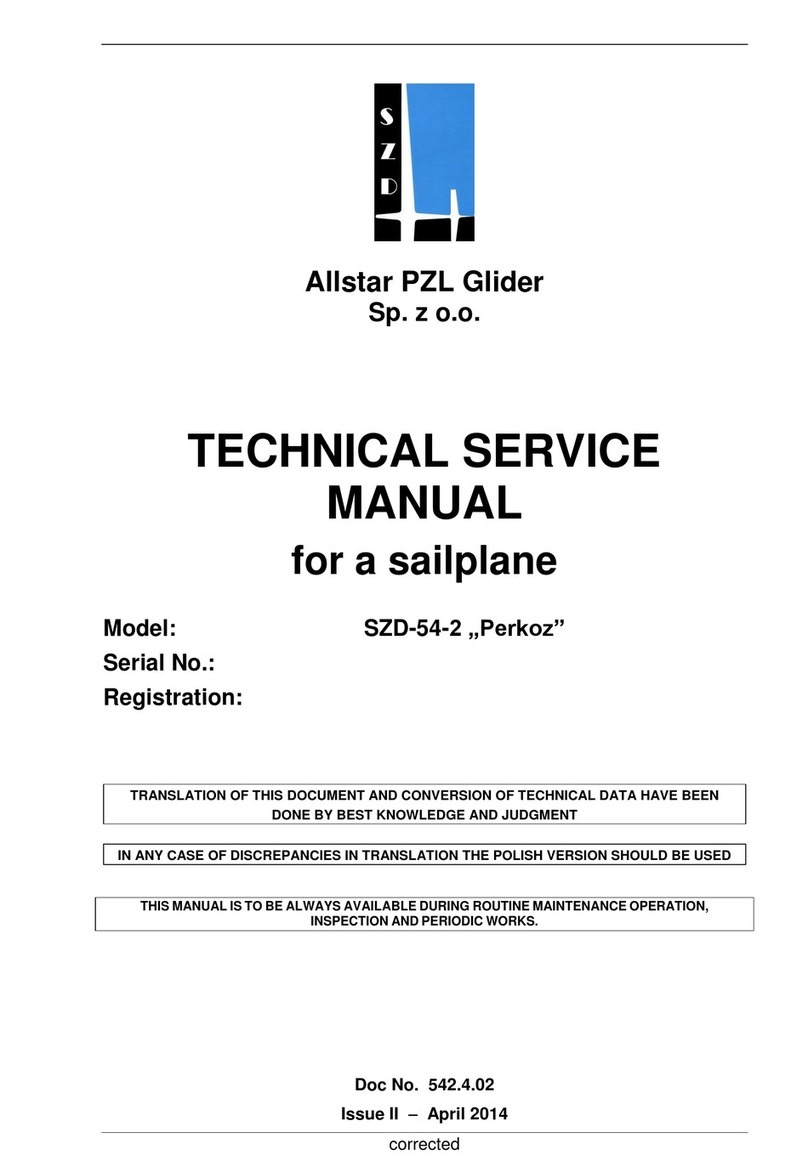
Allstar PZL Glider
Allstar PZL Glider SZD-54-2 Perkoz Technical & service manual
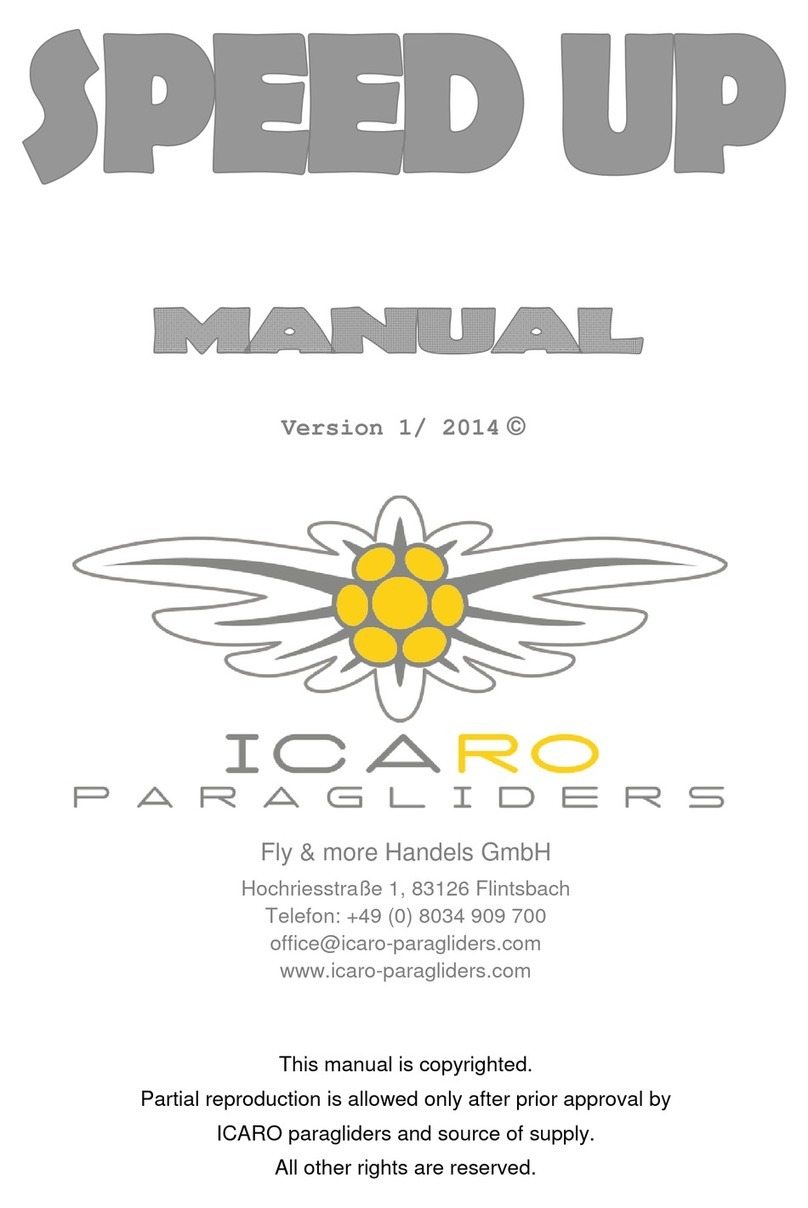
ICARO paragliders
ICARO paragliders SPEEDUP manual
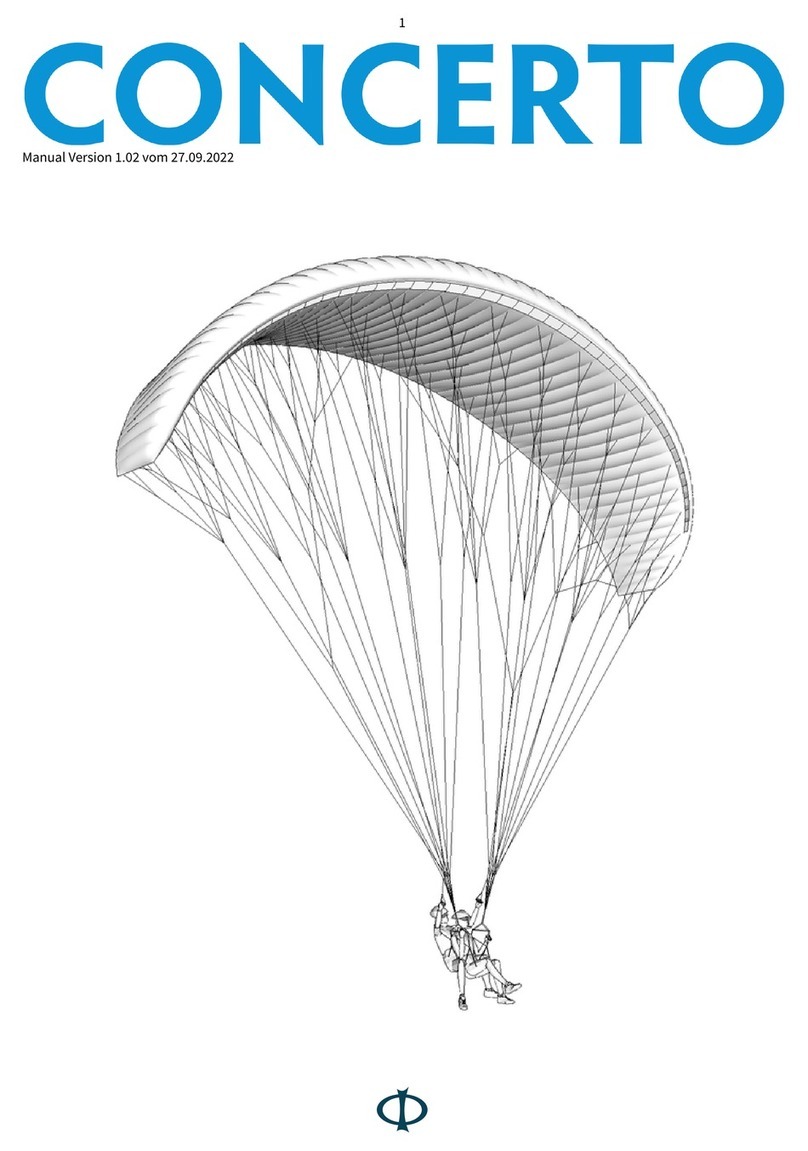
PHI
PHI CONCERTO manual
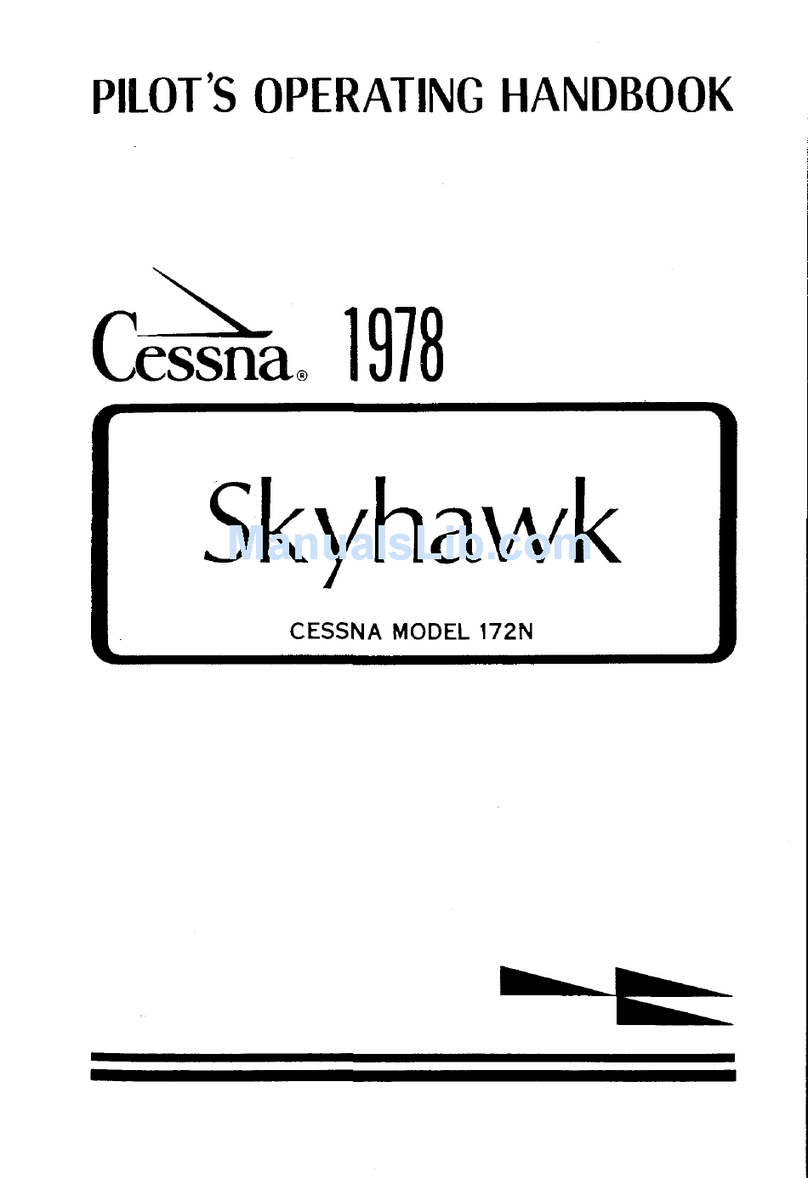
Cessna
Cessna 1978 Skyhawk 172N Pilot operating handbook

